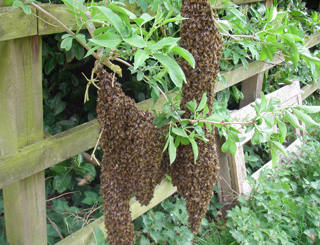
Talk at Flitwick Village Hall for Bedfordshire Beekeepers 15/10/15
by Ged Marshall
- Ged, his daughter and a summer student run 250 colonies and raise 1500 queens a year.
- They are based at Oakfield Honey Farm at Steeple Claydon, near Buckingham.
- They aim to produce 10 tons of honey per year.
- They also take colonies to pollinate orchards, charging £60/colony.
Queens
They import Danish Buckfast breeder queens and raise daughter queens from these. They import further Danish Buckfast queens as drone producing colonies which are placed either side of their mating apiary. It is hoped that the first generation queens produced will not be prone to swarming, and will have a high supersedure rate. They use 14X12 hives. Spare queens are overwintered in Apidea nucs with supers.
Disease
They do a full disease check in April
Combs from any dead colony are burned, boxes are scorched.
Swarm prevention
They re-queen colonies where the queen has done 2 full seasons. Usually in August or September
Swarms collected during the season are also re-queened at this time.
Supers are added once combs in the previous super are covered in bees.
Empty supers are added over a cover board with the holes open, encouraging bees to fill below the cover board first.
Empty supers are added directly above the brood nest, to give the bees space, to try and prevent swarming.
In April and May combs of sealed brood with bees are removed from strong colonies to reduce swarming, they are replaced with sheets of foundation put in the centre of the brood nest of strong colonies.
These combs can be used to boost colonies for queen rearing or to make up nucs, or to boost medium sized colonies to get a strong honey producer. They will not be used to boost small colonies as small colonies will probably be diseased.
Swarm Detection
They don’t have time to look in brood chambers from May – September.
Swarm control
Always check the strongest colony first for swarming. Smaller colonies are less likely to swarm.
If a colony is found to have swarm cells, the queen is killed and 2 cells are left, or 2 chosen cells are given. The cells selected will be the oldest cells possible to get a mated queen as soon as possible. The 2 cells chosen will be side by side so one queen will find and kill the other.
Queenless?
Colonies which appear queenless are either given a test frame or fed to see if this stimulates a queen to start laying.
Bait Hives
Box with an empty frame (no foundation) with a drawn comb on each side. (Wax moths find the gap too drafty)
Or a complete box of comb.
Bait hives place as high as possible, but somewhere they can be easily lifted down when full of bees.
The highest place is often the tallest hive in the apiary.
Swarms
The first sunny day after a spell of rain is spent collecting swarms from hedgerows around apiaries.
Swarms are hived and then moved >3 miles. This means they will not have nest sites in mind and are less likely to abscond. A queen excluder may also be put under a swarm to prevent it absconding.
Queen Introduction
A one day delay between removing the old queen and introducing the new queen will aid acceptance.
To see if bees are likely to accept a queen, lay the queen cage (with the tab on) on top of the cover board hole. Return in 1 or 2 days. If the bees are licking the queen, break off the tab.
Introduce a queen and leave the colony alone for a week, otherwise the queen may be killed. After a week look for eggs, when you see eggs, shut the hive.

